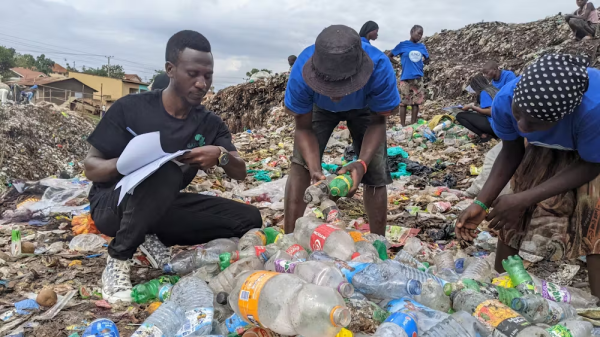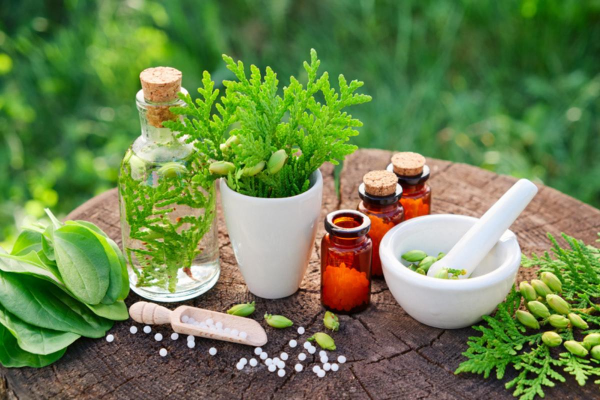By Doug Bierend
Indigenous groups see hope in the environmentally friendly process of bioremediation. But will cities pay attention?


Supported by:
It almost looked like a garden. In Taylor Yard, a former railyard near downtown Los Angeles, volunteers knelt down to tend to scrubby plants growing in neat rows under the sweltering sun.
But beneath the concrete of the 60-acre site overlooking the Los Angeles River, the soils were soaked with an assortment of hazardous heavy metals and petrochemicals like lead, cadmium, diesel, and benzene. As the volunteers worked to dig up entire plants for closer study – some with roots nearly 12ft deep – they wore protective gear and carefully avoided inhaling or touching the toxic soil. Even a brief exposure to the contaminants could cause serious health consequences.
The volunteers were part of a study led by Danielle Stevenson, a researcher with the environmental toxicology department at the University of California, Riverside, investigating how native California plants and fungi could be used to clean up contaminated brownfields: land abandoned or underutilized due to industrial pollution. There are nearly half a million registered brownfields in the United States, about 90,000 of them in California alone. Typically, they are concentrated near or within low-income communities and communities of color, leading to disparate health impacts such as increased likelihood of cancers.
As the culmination of her PhD research last year, Stevenson and her mostly volunteer team had planted California native shrubs and bushes along with symbiotic fungi in plots at three contaminated sites. As the plants established themselves over the course of a year, the team studied how effectively they could suck up contaminants into their roots, shoots and leaves – acting, in Stevenson’s words, “like solar-powered vacuum cleaners”.
According to Stevenson, the soil at Taylor Yard was black, lifeless, and stinking of diesel when her team got to work. Two other sites involved in the study – a former chroming facility in South LA and a former auto shop in the Los Angeles Ecovillage, an intentional neighborhood near Koreatown – were similarly desolate. “There was very little life,” she said. “I didn’t see a worm in the soil, so there weren’t birds. They were bleak.”
Plans are under way to convert Taylor Yard into a park, as part of a $9m grant from the city for revitalization and infrastructure. But before it can be redeveloped, soil contaminants must be dramatically reduced to levels and through methods chosen by the California department of toxic substances control (DTSC), a process done in consultation with site owners and members of the community. For heavy metals, one of the most common options is called dig-and-haul, in which contaminated dirt is simply hauled off in trucks, to be dumped elsewhere and replaced with uncontaminated soil.
The dig-and-haul approach is relatively straightforward and quick. But it can kick up and spread contaminated dust, and do irreversible damage to sites that are culturally or ecologically sensitive. “One reason dig-and-haul is so popular is […] you’re not having to adapt to the site location and its limitations as much,” said Dr Lauren Czaplicki, a Colorado-based environmental engineering scientist.

A growing body of research suggests biology may offer a slower but more environmentally friendly and potentially cost-effective way of decontaminating soils and waterways. Called bioremediation, it involves utilizing plants, fungi, and bacteria to clean up contamination. Through her research, Stevenson sought to explore the bioremediation potential of native California plants, aided by symbiotic fungi, an approach dubbed phyto/mycoremediation.
For the first phase of her study, Stevenson traveled to seven different contaminated sites throughout LA to see what native plants were already thriving despite heavy metal contamination. She then tested the plants to determine which ones were the best metal accumulators. The winners: telegraph weed, California buckwheat, and mulefat. “They ‘volunteered’,” said Stevenson. “They’re very adapted not only to the regional climate conditions but also to the contaminants there.”
Stevenson found significant reductions in heavy metals such as lead, arsenic, and copper across all three sites. She reported that soil composition, irrigation, and the presence or absence of fungi had the largest impact on their reductions.
The findings are preliminary, and much more research is required before the processes are fully understood, let alone widely adopted. Stevenson hopes the methods can eventually provide a protocol that could be regionally adapted to clean up polluted sites almost anywhere using native plants. The Los Angeles brownfields program, which partnered with Stevenson on her research, noted both the potential and limitations of these methods.

“After the conclusion of her study, we were excited to see the results show promise,” the office of the brownfields program said in a statement. The program added that there were “limiting factors” that could hinder the application of Stevenson’s methods elsewhere, such as the time it takes to remove contaminants, and the depth and types of contamination it they address. But the office stated it was open to considering this and other alternative types of remediation if proven effective.
Stevenson’s study has not undergone peer review. Additional research is required before the study is ready for that process, according to Dr Sam Ying, Stevenson’s adviser at UC Riverside.
In the meantime, phyto/mycoremediation has gained the attention of several local Indigenous and environmental justice groups, who see bioremediation as a promising alternative to dig-and-haul, as well as a means of advocating for more responsible land stewardship in southern California and beyond.
Can you (not) dig it?
The former Santa Susana Field Laboratory sits on the edge of the San Fernando Valley. On a hilltop above several residential neighborhoods, the 2,800-acre site is one of the most contaminated places in the country. Opened in 1947, it was host to early rocket tests, liquid metal research, and nuclear experiments, including a radioactive meltdown that was covered up for decades.
For years the question of how to clean up the site has been a pressing and sensitive one for the local community, who point to the lingering contamination as a proximate cause of illnesses.
Today, the land is owned by Boeing and Nasa. But the location is also of deep cultural significance to the Chumash, Gabrieleño, Fernandeño and other nations, whose ancestors left pictographs on cave walls throughout the site.
Following years of delays, the DTSC recently announced the decision to employ dig-and-haul to clean up a former burn pit at the site. Despite assurances that measures will be taken to reduce contaminated dust dispersal and other hazards, some members of the public have expressed frustration over decisions that allegedly emerged from closed-door meetings between DTSC and the site’s owners.

“Their methods have always been very destructive when it comes to cultural resources as well as natural resources,” said Matthew Teutimez, chair of the tribal advisory committee, a group within the California environmental protection agency that represents tribal perspectives and priorities on environmental issues. He is also the tribal biologist for the Kizh Nation, part of the Gabrieleño Band of Mission Indians, the only non-federal tribe on the tribal advisory committee. “We have a whole different concept for how to manage and heal our land, and those concepts are not being integrated.”
Teutimez, who is advising on the Santa Susana Field Laboratory, said tribes’ preference for bioremediation at the site had not been taken seriously until Stevenson presented her research at a meeting with high-level representatives from Boeing, Nasa, and DTSC.
“They won’t make any changes unless there’s data involved, and that’s the big component where [Stevenson] comes in,” said Teutimez, who added: “Her data now can be used to make the point that tribes have been saying for years, that the Earth is able to heal itself.” (The DTSC declined to comment on the matter, citing department policy.)
Without being subject to peer review – a process Stevenson’s study hasn’t undergone yet – and a series of feasibility studies, phyto/mycoremediation is unlikely to be approved and utilized by regulatory and oversight agencies, except as part of limited pilot studies. But the early evidence of its potential has already inspired local Indigenous and environmental justice groups to do their own tests of the methods as they champion the adoption of bioremediation on sensitive sites.
South of Los Angeles, bioremediation is being taken up as a means of community empowerment. Orange County Environmental Justice (OCEJ), a non-profit formed in 2016 to address environmental concerns among the area’s low-income and marginalized communities, approached Stevenson about applying phyto/mycoremediation in and around Santa Ana.
“It really fit well with the kind of ethos we’ve been trying to embody, which is that all of these solutions and changes we’re trying to push for need to be in collaboration with Indigenous peoples,” said Patricia Jovel Flores, executive director of OCEJ.

Stevenson and OCEJ are coordinating to test phyto/mycoremediation at the Puvungna sacred site. Situated on what is now property of California State University Long Beach, the ancient village and ceremonial site is of profound importance to the Tongva and Acjachemen nations. For decades there has been contention between the university and Indigenous communities over stewardship of the site, including plans to build a strip mall and a parking lot on the grounds. In 2019, the university dumped debris from a dormitory construction project, including heavy-metal-laden soils, on the site. A lawsuit and settlement later prohibited the university from further damaging the site, but let it off the hook for removing the construction debris.
OCEJ is leading clean up efforts at Puvungna, including testing phyto/mycoremediation as part of a broader effort to train community members in bioremediation and permaculture methods, and to make these the preferred approach for the city as it issues contracts for cleanup. “We basically want to be able to train the workforce so that those jobs stay within our community,” said Flores.
The interest of groups like OCEJ shows an appetite for alternatives to the status quo for cleanup, and illustrates a tension between the priorities and agency of Indigenous and marginalized communities, and those of site owners and regulators.
“What I keep hearing from communities is that trust has been so broken, because the consultation they feel can be like a token gesture,” said Stevenson.
For his part, Teutimez hopes that, if phyto/mycoremediation can be successfully deployed on federally recognized tribal lands in California, then it can also be used by the broader network of federal tribes.
“I want to bring these solutions to tribal lands, to then show the state and the federal government … how these techniques can be used,” he said. “Once it goes from federal tribes in California, you can go to federal tribes such as Fort Mojave, which is Nevada and Arizona.”




You must be logged in to post a comment.